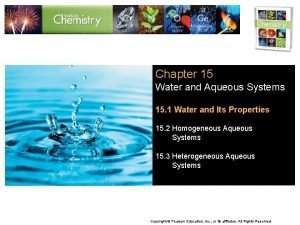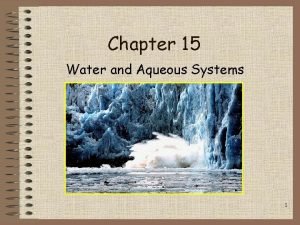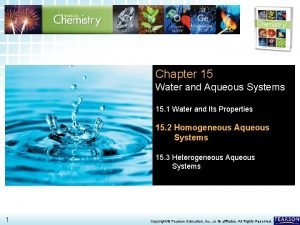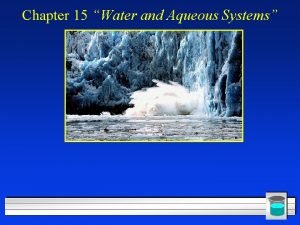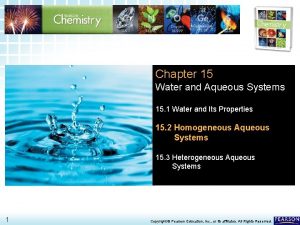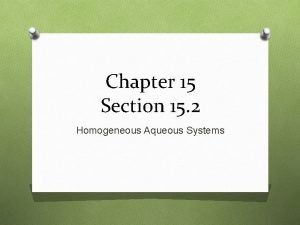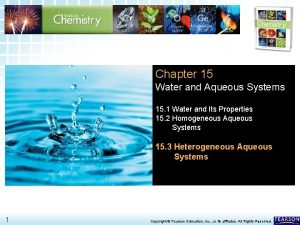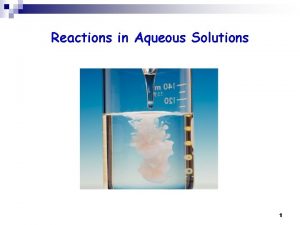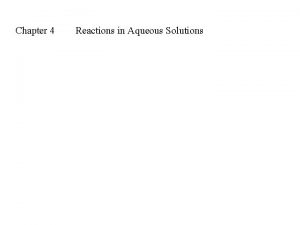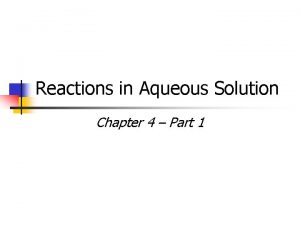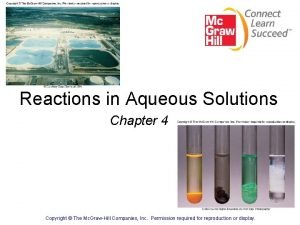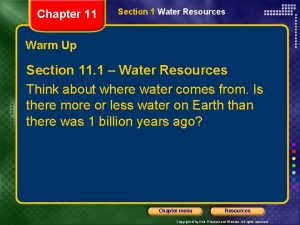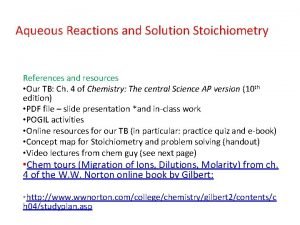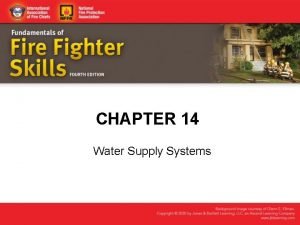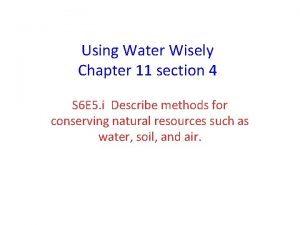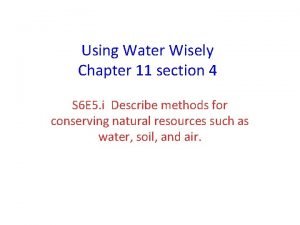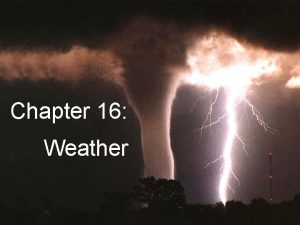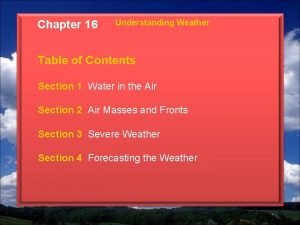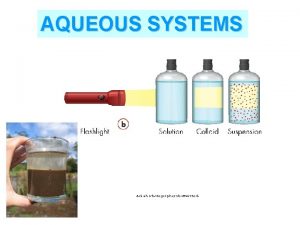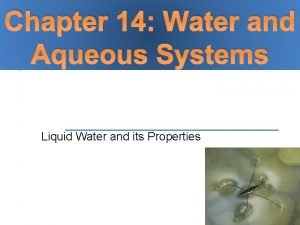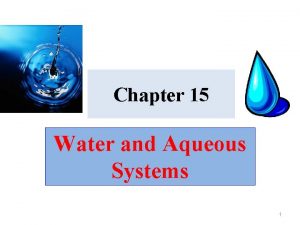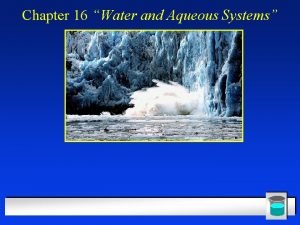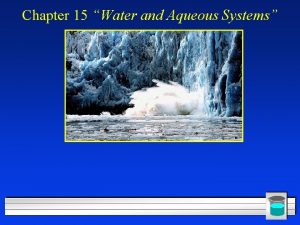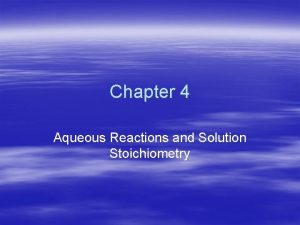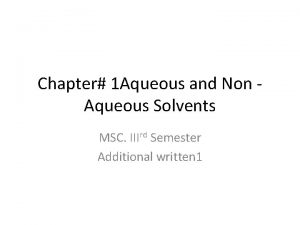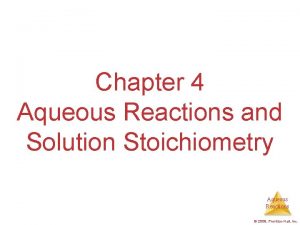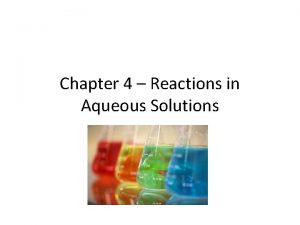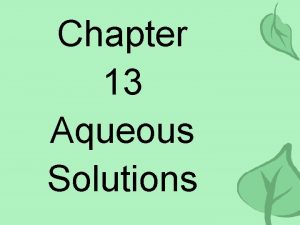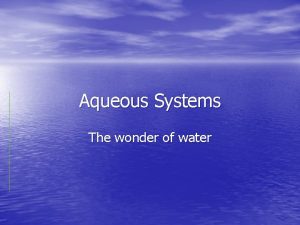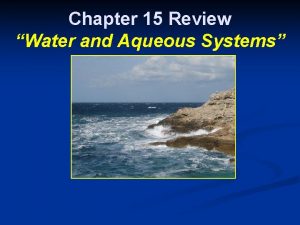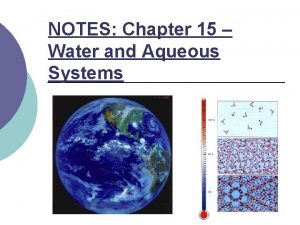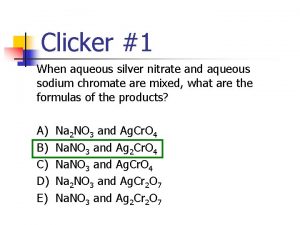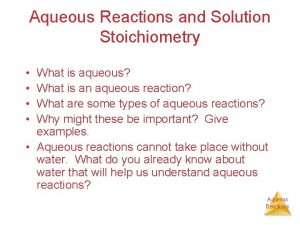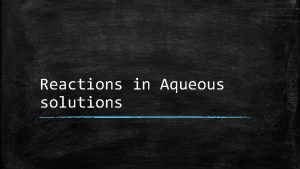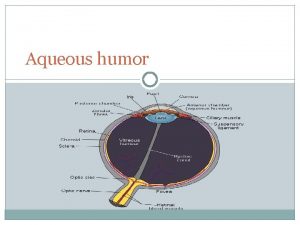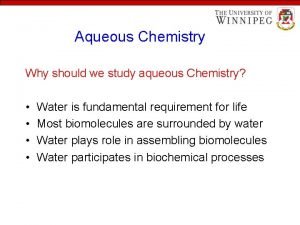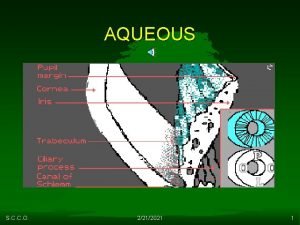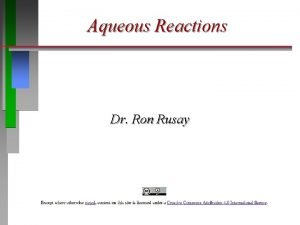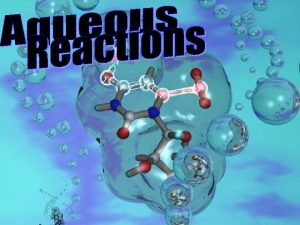Chapter 15 Water and Aqueous Systems Section 15

























- Slides: 25

Chapter 15 “Water and Aqueous Systems”

Section 15. 2 Homogeneous Aqueous Solutions l OBJECTIVES: –Distinguish between a solvent and a solute.

Section 15. 2 Homogeneous Aqueous Solutions l OBJECTIVES: –Describe what happens in the solution process.

Section 15. 2 Homogeneous Aqueous Solutions l OBJECTIVES: –Explain why all ionic compounds are known as electrolytes.

Section 15. 2 Homogeneous Aqueous Solutions l OBJECTIVES: –Demonstrate how the formula for a hydrate is written.

Solvents and Solutes l 1) 2) l l Solution - a homogenous mixture, that is mixed molecule by molecule; made of: a Solvent - the dissolving medium a Solute - the dissolved particles Aqueous solution- a solution with water as the solvent. Particle size is less than 1 nm; cannot be separated by filtration – Fig. 15. 6, p. 450

Parts of a Solution: 1. the Solute A solute is the dissolved substance in a solution. Salt in salt water Sugar in soda drinks Carbon dioxide in soda drinks 2. the Solvent A solvent is the dissolving medium in a solution. Water in salt water Water in soda

Solutions l Keep in mind that solutions do not have to contain water, but this is the type we are studying in this chapter = aqueous solutions

Solvents There a tremendous number of solutions we use in our daily lives!

Concentrated vs. Dilute Concentrated Dilute Lots of solute, but little solvent Lots of solvent, but little solute

Aqueous Solutions l Water dissolves ionic compounds and polar covalent molecules very well. rule is: “like dissolves like” l Polar dissolves polar. l Nonpolar dissolves nonpolar. l Oil is nonpolar. – Oil and water don’t mix. l Salt is ionic- makes salt water. l The

The Solution Process l Called “solvation”. l Water 1) breaks the + and - charged pieces apart, and 2) surrounds them. l Fig. 15. 7, p. 451 l But, in some ionic compounds, the attraction between ions is greater than the attraction exerted by water – Barium sulfate and calcium carbonate do not dissolve in water!

How Ionic solids dissolve in water These ions have been pulled away from the main crystal structure by water’s polarity. H O H H H O O H H H O H H These ions have been surrounded by water, and are now dissolved!

l Solids will dissolve if the attractive force of the water molecules is stronger than the attractive force of the crystal. l If not, the solids are insoluble. l Water doesn’t dissolve nonpolar molecules (like oil) because the water molecules can’t hold onto them. l The water molecules hold onto other water molecules, and separate from the nonpolar molecules. l Nonpolars? No repulsion between them

Electrolytes and Nonelectrolytes l Electrolytes- compounds that conduct an electric current in aqueous solution, or in the molten state – all ionic compounds are electrolytes because they dissociate into ions (they are also called “salts”) l barium sulfate- will conduct when molten, but is insoluble in water!

Electrolytes and Nonelectrolytes l Do not conduct? = Nonelectrolytes. – Most are molecular materials, because they do not have ions l Not all electrolytes conduct to the same degree – there are weak electrolytes, and strong electrolytes – depends on: the degree of ionization

Electrolytes vs. Nonelectrolytes The ammeter measures the flow of electrons (current) through the circuit. ü If the ammeter measures a current and the bulb glows, then the solution conducts. ü If the ammeter fails to measure a current and the bulb does not glow, the solution is non-conducting.

Electrolytes and Nonelectrolytes l Strong electrolytes exist as nearly 100 % ions l Weak electrolytes have only a fraction of the solute that exists as ions l How do you know if it is strong or weak? Refer to the rules on the handout sheet.

Electrolyte Summary l Substances that conduct electricity when dissolved in water, or molten. l Must have charged particles that can move. l Ionic compounds break into charged ions: Na. Cl ® Na 1+ and Cl 1 l These ions can conduct electricity.

l Nonelectrolytes do not conduct electricity when dissolved in water or molten l Polar covalent molecules such as methanol (CH 3 OH) don’t fall apart into ions when they dissolve. l Weak electrolytes don’t fall completely apart into ions. l Strong electrolytes do ionize completely.

Water of Hydration (or Water of Crystallization) Water molecules are chemically bonded to solid salt molecules (not in solution) l These compounds have fixed amounts of water. l The water can be driven off by heating: l Hydrate . + heat Anhydrous Cu. SO 4 5 H 2 O Cu. SO 4 + 5 H 2 O - heat l Called copper(II)sulfate pentahydrate. l

Hydrates l Table 15. 2, p. 455 list some familiar hydrates l Since heat can drive off the water, the forces holding the water are weak l If a hydrate has a vapor pressure higher than that of water vapor in air, the hydrate will effloresce by losing the water of hydration

Hydrates l Some hydrates that have a low vapor pressure remove water from the air to form higher hydrates- these are called hygroscopic – used as drying agents, or dessicants – packaged with products to absorb moisture

- Page 456

Hydrates l Some compounds are so hygroscopic, they become wet when exposed to normally moist air - called deliquescent –remove sufficient water to dissolve completely and form solutions: Fig. 15. 13, page 457
 Tyndall effect
Tyndall effect Water and aqueous systems chapter 15 answers
Water and aqueous systems chapter 15 answers Chapter 15 water and aqueous systems
Chapter 15 water and aqueous systems Chapter 15 water and aqueous systems
Chapter 15 water and aqueous systems Chapter 15 water and aqueous systems
Chapter 15 water and aqueous systems Water and water and water water
Water and water and water water Homogeneous aqueous systems
Homogeneous aqueous systems Suspension vs solution
Suspension vs solution Is water aqueous
Is water aqueous Types of reactions
Types of reactions Modern chemistry chapter 13 review answers
Modern chemistry chapter 13 review answers Chapter 4 reactions in aqueous solutions
Chapter 4 reactions in aqueous solutions Chapter 4 reactions in aqueous solutions
Chapter 4 reactions in aqueous solutions Chapter 4 reactions in aqueous solutions worksheet answers
Chapter 4 reactions in aqueous solutions worksheet answers Chapter 4 reactions in aqueous solutions
Chapter 4 reactions in aqueous solutions Chapter 11 section 3 water pollution answer key
Chapter 11 section 3 water pollution answer key Chemistry in biology chapter 6
Chemistry in biology chapter 6 Aqueous reactions and solution stoichiometry
Aqueous reactions and solution stoichiometry Ions in aqueous solutions and colligative properties
Ions in aqueous solutions and colligative properties The number of tankers needed for a fire will depend on the
The number of tankers needed for a fire will depend on the Class 8 english chapter 7 water water everywhere
Class 8 english chapter 7 water water everywhere Chapter 36 section 1 reproductive systems
Chapter 36 section 1 reproductive systems Chapter 11 section 4 using water wisely answer key
Chapter 11 section 4 using water wisely answer key Using water wisely
Using water wisely Chapter 16 section 1 water in the air answer key
Chapter 16 section 1 water in the air answer key Chapter 16 understanding weather answer key
Chapter 16 understanding weather answer key
